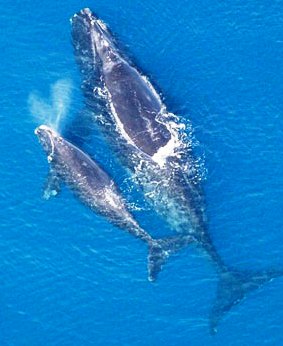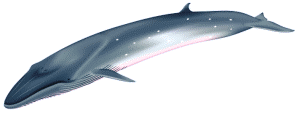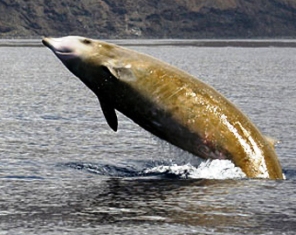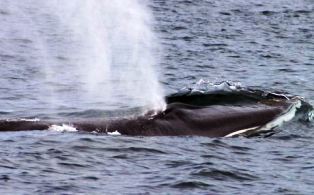Discover Florida Nature
It's time to explore the natural Florida


|
|
|
|
|
 Atlantic
Northern Right Whale- Right whales are large baleen whales.
Adults are generally between 45 and 55 feet in length and can weigh up
to 70 tons. Females are larger than males. Calves are 13-15 feet in
length at birth. Distinguishing features for right whales include a
stocky body, generally black coloration (although some individuals have
white patches on their undersides), lack of a dorsal fin, and a large
head. Two rows of long (up to eight feet in length) dark baleen plates
hang from the upper jaw, with about 225 plates on each side. The tail is
broad, deeply notched, and all black with a smooth trailing edge. The
North Atlantic right whale is among the most
endangered of the
world’s large whales with an estimated population of 350-400
individuals. Historically depleted by commercial whaling, ship strikes
and fishing gear entanglements are now the largest threats to right
whales. The coastal waters off Florida and Georgia are the only known
calving area for North Atlantic right whales and these waters have been
designated as right whale critical habitat by the National Marine
Fisheries Service. Right whales are typically sighted off Florida
between November and April. The primary food sources for the Atlantic
Northern Right Whale are zooplankton, including copepods, euphausiids,
and cyprids. Unlike other baleen whales, right whales are skimmers: they
feed by removing prey from the water using baleen while moving with
their mouth open through a patch of zooplankton. Atlantic
Northern Right Whale- Right whales are large baleen whales.
Adults are generally between 45 and 55 feet in length and can weigh up
to 70 tons. Females are larger than males. Calves are 13-15 feet in
length at birth. Distinguishing features for right whales include a
stocky body, generally black coloration (although some individuals have
white patches on their undersides), lack of a dorsal fin, and a large
head. Two rows of long (up to eight feet in length) dark baleen plates
hang from the upper jaw, with about 225 plates on each side. The tail is
broad, deeply notched, and all black with a smooth trailing edge. The
North Atlantic right whale is among the most
endangered of the
world’s large whales with an estimated population of 350-400
individuals. Historically depleted by commercial whaling, ship strikes
and fishing gear entanglements are now the largest threats to right
whales. The coastal waters off Florida and Georgia are the only known
calving area for North Atlantic right whales and these waters have been
designated as right whale critical habitat by the National Marine
Fisheries Service. Right whales are typically sighted off Florida
between November and April. The primary food sources for the Atlantic
Northern Right Whale are zooplankton, including copepods, euphausiids,
and cyprids. Unlike other baleen whales, right whales are skimmers: they
feed by removing prey from the water using baleen while moving with
their mouth open through a patch of zooplankton. Bryde's
Whale and Sei Whale-
Sei and Bryde's whales are so similar that it was not until the early
1900's that the whalers realized they were hunting two different
species. Field identification between the two species is still difficult
until one is close enough to see whether there are three ridges on top
of the head (Bryde's whale) or just one (sei whale). To add to the
confusion, some populations of Bryde's whales vary in size, color, and
baleen structure in different geographical locations.
Both sei and Bryde's whales have a bluish-gray body with white on the
underside. Some of them have dark gray or almost white scars that may be
caused by bites of lampreys. Sei and Bryde's are both baleen whales;
they have a series of fringed, overlapping plates that hang from the
upper jaw where teeth Bryde's
Whale and Sei Whale-
Sei and Bryde's whales are so similar that it was not until the early
1900's that the whalers realized they were hunting two different
species. Field identification between the two species is still difficult
until one is close enough to see whether there are three ridges on top
of the head (Bryde's whale) or just one (sei whale). To add to the
confusion, some populations of Bryde's whales vary in size, color, and
baleen structure in different geographical locations.
Both sei and Bryde's whales have a bluish-gray body with white on the
underside. Some of them have dark gray or almost white scars that may be
caused by bites of lampreys. Sei and Bryde's are both baleen whales;
they have a series of fringed, overlapping plates that hang from the
upper jaw where teeth
 would
be. The plates are composed of a fingernail-like material called keratin
that frays out into fine hairs on the ends and inside the mouth next to
the tongue. The adult male sei whale measures 45 to 55 feet, sometimes
reaching a length of 65 feet, and weighs about 14 to 17 tons. The
Bryde's whale is smaller, and the adult male measures 40 to 50 feet and
weights about 13 tons. Females are slightly larger than males in both
species. Both species are usually found as solitary animals, or in small
groups of 2 to 3. Bryde's whales rarely venture beyond 40 degree north
or south, and are most common in tropical and sub-tropical waters. Sei
whales are found near the Antarctic, and go as far north as Iceland in
the North Atlantic. The sei whale is an
endangered species in Florida. would
be. The plates are composed of a fingernail-like material called keratin
that frays out into fine hairs on the ends and inside the mouth next to
the tongue. The adult male sei whale measures 45 to 55 feet, sometimes
reaching a length of 65 feet, and weighs about 14 to 17 tons. The
Bryde's whale is smaller, and the adult male measures 40 to 50 feet and
weights about 13 tons. Females are slightly larger than males in both
species. Both species are usually found as solitary animals, or in small
groups of 2 to 3. Bryde's whales rarely venture beyond 40 degree north
or south, and are most common in tropical and sub-tropical waters. Sei
whales are found near the Antarctic, and go as far north as Iceland in
the North Atlantic. The sei whale is an
endangered species in Florida. Cuvier's
Beaked Whale-Cuvier's beaked whale, also known as the goosebeak
whale, is one of twenty named species of beaked whales. It is so rarely
seen that almost everything known about this small whale has come from
studying stranded animals. Cuvier's beaked whale has a tendency to
strand more often than any other species of beaked whales. Stranded
specimens have been noted in all oceans of the world except in both
polar regions, an indication of an extremely wide distribution. This
whale varies greatly in color. Its back may be rusty-brown, dark gray,
or fawn colored and the underside of the body may be dark brown or
black. As the Cuvier's beaked whale ages, first the head and neck and
then the body become more lightly colored; the heads of old males are
almost completely white. The back and sides of this whale, especially
the males, are often covered with double-lined scratches caused by the
teeth of other males. Its sides and belly are covered with oval white
patches. Maximum size is 23 feet, but the average adult is 18 feet and
weighs 2.7 tons. Squid is the Cuvier's Beaked Whale's primary food,
though it sometimes eats fish and, rarely, crustaceans. Cuvier's beaked
whales are found in all the oceans of the world except the polar regions
of both hemispheres. They prefer deep water of over 3,300 feet and avoid
shallow coastal areas. Cuvier's
Beaked Whale-Cuvier's beaked whale, also known as the goosebeak
whale, is one of twenty named species of beaked whales. It is so rarely
seen that almost everything known about this small whale has come from
studying stranded animals. Cuvier's beaked whale has a tendency to
strand more often than any other species of beaked whales. Stranded
specimens have been noted in all oceans of the world except in both
polar regions, an indication of an extremely wide distribution. This
whale varies greatly in color. Its back may be rusty-brown, dark gray,
or fawn colored and the underside of the body may be dark brown or
black. As the Cuvier's beaked whale ages, first the head and neck and
then the body become more lightly colored; the heads of old males are
almost completely white. The back and sides of this whale, especially
the males, are often covered with double-lined scratches caused by the
teeth of other males. Its sides and belly are covered with oval white
patches. Maximum size is 23 feet, but the average adult is 18 feet and
weighs 2.7 tons. Squid is the Cuvier's Beaked Whale's primary food,
though it sometimes eats fish and, rarely, crustaceans. Cuvier's beaked
whales are found in all the oceans of the world except the polar regions
of both hemispheres. They prefer deep water of over 3,300 feet and avoid
shallow coastal areas. Fin
Whale- The fin whale is one of the rorquals, a family that
includes the humpback whale, blue whale, Bryde's whale, sei whale, and
minke whale. Rorquals all have a dorsal fin and throat grooves that
expand when the animal is feeding. The fin, or finback whale is second
only to the blue whale in size and weight. Among the fastest of the
great whales, it is capable of bursts of speed of up to 23 mph, leading
to its description as the "greyhound of the sea." Its most unusual
characteristic is the asymmetrical coloring of the lower jaw, which is
white or creamy yellow on the right side and mottled black on the left
side. Fin whales are found in all oceans of the world, though they seem
to prefer temperate and polar waters to tropical seas.
The fin whale is long, sleek, and streamlined, with a V-shaped head
which is flat on top. A single ridge extends from the blowhole to the
tip of the rostrum (upper jaw).
The fin whale is light gray to brownish-black on its back and sides.
Adult males measure up to 78 feet in the northern hemisphere. Females
are slightly larger than males. Weight for both sexes is between 50-70
tons. Fin whales feed
mainly on small shrimp-like creatures called krill or euphausiids and
schooling fish. They have been observed circling schools of fish at high
speed, rolling the fish into compact balls then turning on their right
side to engulf the fish.
Fin whales are found in all oceans of the world. They may migrate to
subtropical waters, such as the waters off the coast of Florida, for
mating and calving during the winter months and to the colder areas of
the Arctic and Antarctic for feeding during the summer months. Fin
Whale- The fin whale is one of the rorquals, a family that
includes the humpback whale, blue whale, Bryde's whale, sei whale, and
minke whale. Rorquals all have a dorsal fin and throat grooves that
expand when the animal is feeding. The fin, or finback whale is second
only to the blue whale in size and weight. Among the fastest of the
great whales, it is capable of bursts of speed of up to 23 mph, leading
to its description as the "greyhound of the sea." Its most unusual
characteristic is the asymmetrical coloring of the lower jaw, which is
white or creamy yellow on the right side and mottled black on the left
side. Fin whales are found in all oceans of the world, though they seem
to prefer temperate and polar waters to tropical seas.
The fin whale is long, sleek, and streamlined, with a V-shaped head
which is flat on top. A single ridge extends from the blowhole to the
tip of the rostrum (upper jaw).
The fin whale is light gray to brownish-black on its back and sides.
Adult males measure up to 78 feet in the northern hemisphere. Females
are slightly larger than males. Weight for both sexes is between 50-70
tons. Fin whales feed
mainly on small shrimp-like creatures called krill or euphausiids and
schooling fish. They have been observed circling schools of fish at high
speed, rolling the fish into compact balls then turning on their right
side to engulf the fish.
Fin whales are found in all oceans of the world. They may migrate to
subtropical waters, such as the waters off the coast of Florida, for
mating and calving during the winter months and to the colder areas of
the Arctic and Antarctic for feeding during the summer months.
|
|
|
Advertise | Privacy Statement | Dog Encyclopedia | Video |Contact | Alaska Nature |
|